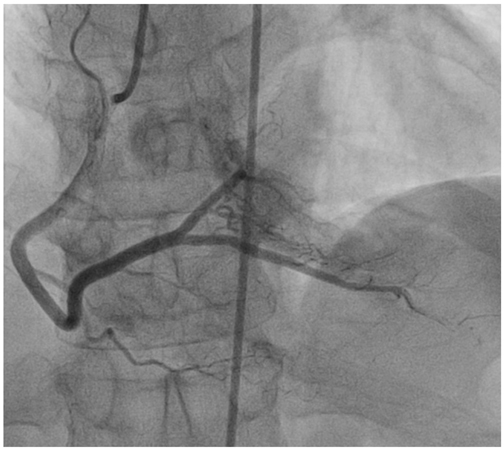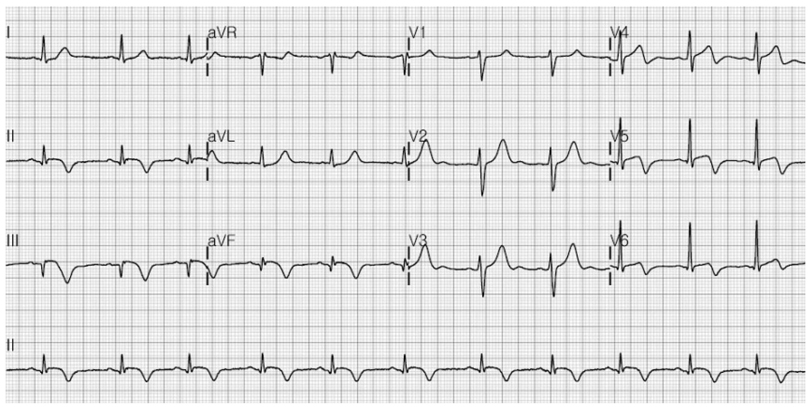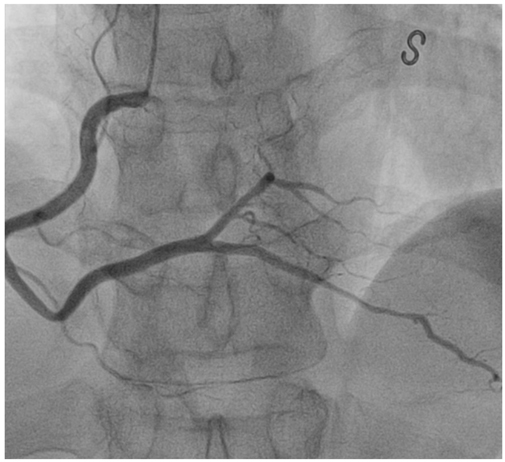Korean Circ J.
2012 Feb;42(2):133-135. 10.4070/kcj.2012.42.2.133.
A Case of Acute Carbon Monoxide Poisoning Resulting in an ST Elevation Myocardial Infarction
- Affiliations
-
- 1Division of Cardiology, Internal Medicine, Konkuk University Chungju Hospital, Chungju, Korea. gilll@paran.com
- 2Division of Hemato-Oncology, Internal Medicine, Inha University Hospital, Incheon, Korea.
- KMID: 1826388
- DOI: http://doi.org/10.4070/kcj.2012.42.2.133
Abstract
- Carbon monoxide (CO) is a well-known chemical asphyxiant, which causes tissue hypoxia with prominent neurological and cardiovascular injury. After exposure to CO, several cardiac manifestations have been reported, including arrhythmias, acute myocardial infarction, and pulmonary edema. However, an ST elevation myocardial infarction (STEMI) due to CO poisoning is a very rare presentation, and the treatment for STEMI due to CO poisoning is not well established. Here, we report a rare case of STEMI complicated by increased thrombogenicity secondary to acute CO poisoning and complete revascularization after antithrombotic treatment.
Keyword
MeSH Terms
Figure
Reference
-
1. McCabe MJ, Weston CF, Fraser AG. Acute myocardial infarction related to smoke inhalation and myocardial bridging. Postgrad Med J. 1992. 68:758–761.2. Aronow WS. Effect of carbon monoxide on cardiovascular disease. Prev Med. 1979. 8:271–278.3. Weaver LK. Clinical practice: carbon monoxide poisoning. N Engl J Med. 2009. 360:1217–1225.4. Chong DY, Lee Y, Cho SH, Song KY. Electron Microscopic Study on mitochondria and cytochrome oxidase activity following acute carbon monoxide exposure in rat myocardium. Korean Circ J. 1988. 18:69–83.5. Gandini C, Castoldi AF, Candura SM, et al. Carbon monoxide cardiotoxicity. J Toxicol Clin Toxicol. 2001. 39:35–44.6. McMeekin JD, Finegan BA. Reversible myocardial dysfunction following carbon monoxide poisoning. Can J Cardiol. 1987. 3:118–121.7. Allred EN, Bleecker ER, Chaitman BR, et al. Short term effects of carbon monoxide exposure on the exercise performance of subjects with coronary artery disease. N Engl J Med. 1989. 321:1426–1432.8. Hsu PC, Lin TH, Su HM, et al. Acute carbon monoxide poisoning resulting in ST elevation myocardial infarction: a rare case report. Kaohsiung J Med Sci. 2010. 26:271–275.9. Raub JA, Mathieu-Nolf M, Hampson NB, Thom SR. Carbon monoxide poisoning: a public health perspective. Toxicology. 2000. 145:1–14.10. Satran D, Henry CR, Adkinson C, Nicholson CI, Bracha Y, Henry TD. Cardiovascular manifestations of moderate to severe carbon monoxide poisoning. J Am Coll Cardiol. 2005. 45:1513–1516.11. Marius-Nunez AL. Myocardial infarction with normal coronary arteries after acute exposure to carbon monoxide. Chest. 1990. 97:491–494.12. Hampson NB, Hauff NM. Carboxyhemoglobin levels in carbon monoxide poisoning: do they correlate with the clinical picture? Am J Emerg Med. 2008. 26:665–673.
- Full Text Links
- Actions
-
Cited
- CITED
-
- Close
- Share
- Similar articles
-
- Cerebral Infarction Followed by Hemorrhagic Transformation Accompanied by Carbon Monoxide Poisoning
- Acute Cerebral Infarction in Carbon Monoxide Poisoning
- Pulmonary edema in acute carbon monoxide poisoning
- A Clinical Observation of Acute Carbon Monoxide Poisoning
- Chorea as a Clinical Manifestation of Delayed Neurologic Sequelae in Carbon Monoxide Poisoning: Case Report





